#1
sho_sho
عضوة مـآسية
بيانات العضوة
- رقم العضوية : 9247
- تاريخ التسجيل: 123Jun 2011
- الدولة : مصر
- المدينة : دمياط
- الحالة الاجتماعية : متزوجة
- الوظيفة : ربة منزل
- المشاركات: 10,143 [+]
- الأصدقاء : 171
- نقاط التقييم : 14
 The Quran on Human Embryonic Development:
The Quran on Human Embryonic Development:
A) The Quran on Human Embryonic Development:
In the Holy Quran, God speaks about the stages of man’s embryonic development:
 We created man from an extract of clay. Then We made him as a drop in a place of settlement, firmly fixed. Then We made the drop into an alaqah (leech, suspended thing, and blood clot), then We made the alaqah into a mudghah (chewed substance)...
We created man from an extract of clay. Then We made him as a drop in a place of settlement, firmly fixed. Then We made the drop into an alaqah (leech, suspended thing, and blood clot), then We made the alaqah into a mudghah (chewed substance)...  1 (Quran, 23:12-14)
1 (Quran, 23:12-14)
Literally, the Arabic word alaqah has three meanings: (1) leech, (2) suspended thing, and (3) blood clot.
In comparing a leech to an embryo in the alaqah stage, we find similarity between the two2 as we can see in figure 1. Also, the embryo at this stage obtains nourishment from the blood of the mother, similar to the leech, which feeds on the blood of others.3
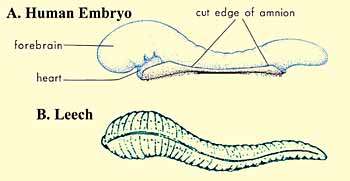 Figure 1: Drawings illustrating the similarities in appearance between a leech and a human embryo at the alaqah stage. (Leech drawing from Human Development as Described in the Quran and Sunnah, Moore and others, p. 37, modified from Integrated Principles of Zoology, Hickman and others. Embryo drawing from The Developing Human, Moore and Persaud, 5th ed., p. 73.)
Figure 1: Drawings illustrating the similarities in appearance between a leech and a human embryo at the alaqah stage. (Leech drawing from Human Development as Described in the Quran and Sunnah, Moore and others, p. 37, modified from Integrated Principles of Zoology, Hickman and others. Embryo drawing from The Developing Human, Moore and Persaud, 5th ed., p. 73.)
The second meaning of the word alaqah is “suspended thing.” This is what we can see in figures 2 and 3, the suspension of the embryo, during the alaqah stage, in the womb of the mother.
The next stage mentioned in the verse is the mudghah stage. The Arabic word mudghah means “chewed substance.” If one were to take a piece of gum and chew it in his or her mouth and then compare it with an embryo at the mudghah stage, we would conclude that the embryo at the mudghah stage acquires the appearance of a chewed substance. This is because of the somites at the back of the embryo that “somewhat resemble teethmarks in a chewed substance.”6 (see figures 5 and 6).
 have possibly known all this 1400 years ago, when scientists have only recently discovered this using advanced equipment and powerful microscopes which did not exist at that time? Hamm and Leeuwenhoek were the first scientists to observe human sperm cells (spermatozoa) using an improved microscope in 1677 (more than 1000 years after Muhammad
have possibly known all this 1400 years ago, when scientists have only recently discovered this using advanced equipment and powerful microscopes which did not exist at that time? Hamm and Leeuwenhoek were the first scientists to observe human sperm cells (spermatozoa) using an improved microscope in 1677 (more than 1000 years after Muhammad  ). They mistakenly thought that the sperm cell contained a miniature preformed human being that grew when it was deposited in the female genital tract.7
). They mistakenly thought that the sperm cell contained a miniature preformed human being that grew when it was deposited in the female genital tract.7
Professor Emeritus Keith L. Moore8 is one of the world’s most prominent scientists in the fields of anatomy and embryology and is the author of the book entitled The Developing Human, which has been translated into eight languages. This book is a scientific reference work and was chosen by a special committee in the United States as the best book authored by one person. Dr. Keith Moore is Professor Emeritus of Anatomy and Cell Biology at the University of Toronto, Toronto, Canada. There, he was Associate Dean of Basic Sciences at the Faculty of Medicine and for 8 years was the Chairman of the Department of Anatomy. In 1984, he received the most distinguished award presented in the field of anatomy in Canada, the J.C.B. Grant Award from the Canadian Association of Anatomists. He has directed many international associations, such as the Canadian and American Association of Anatomists and the Council of the Union of Biological Sciences.
In 1981, during the Seventh Medical Conference in Dammam, Saudi Arabia, Professor Moore said: “It has been a great pleasure for me to help clarify statements in the Quran about human development. It is clear to me that these statements must have come to Muhammad from God, because almost all of this knowledge was not discovered until many centuries later. This proves to me that Muhammad must have been a messenger of God.”9 (To view the RealPlayer video of this comment click here ).
).
Consequently, Professor Moore was asked the following question: “Does this mean that you believe that the Quran is the word of God?” He replied: “I find no difficulty in accepting this.”10
During one conference, Professor Moore stated: “....Because the staging of human embryos is complex, owing to the continuous process of change during development, it is proposed that a new system of classification could be developed using the terms mentioned in the Quran and Sunnah (what Muhammad said, did, or approved of). The proposed system is simple, comprehensive, and conforms with present embryological knowledge. The intensive studies of the Quran and hadeeth (reliably transmitted reports by the Prophet Muhammad’s
said, did, or approved of). The proposed system is simple, comprehensive, and conforms with present embryological knowledge. The intensive studies of the Quran and hadeeth (reliably transmitted reports by the Prophet Muhammad’s  companions of what he said, did, or approved of) in the last four years have revealed a system for classifying human embryos that is amazing since it was recorded in the seventh century A.D. Although Aristotle, the founder of the science of embryology, realized that chick embryos developed in stages from his studies of hen’s eggs in the fourth century B.C., he did not give any details about these stages. As far as it is known from the history of embryology, little was known about the staging and classification of human embryos until the twentieth century. For this reason, the descriptions of the human embryo in the Quran cannot be based on scientific knowledge in the seventh century. The only reasonable conclusion is: these descriptions were revealed to Muhammad from God. He could not have known such details because he was an illiterate man with absolutely no scientific training.”11
companions of what he said, did, or approved of) in the last four years have revealed a system for classifying human embryos that is amazing since it was recorded in the seventh century A.D. Although Aristotle, the founder of the science of embryology, realized that chick embryos developed in stages from his studies of hen’s eggs in the fourth century B.C., he did not give any details about these stages. As far as it is known from the history of embryology, little was known about the staging and classification of human embryos until the twentieth century. For this reason, the descriptions of the human embryo in the Quran cannot be based on scientific knowledge in the seventh century. The only reasonable conclusion is: these descriptions were revealed to Muhammad from God. He could not have known such details because he was an illiterate man with absolutely no scientific training.”11
In the Holy Quran, God speaks about the stages of man’s embryonic development:
 We created man from an extract of clay. Then We made him as a drop in a place of settlement, firmly fixed. Then We made the drop into an alaqah (leech, suspended thing, and blood clot), then We made the alaqah into a mudghah (chewed substance)...
We created man from an extract of clay. Then We made him as a drop in a place of settlement, firmly fixed. Then We made the drop into an alaqah (leech, suspended thing, and blood clot), then We made the alaqah into a mudghah (chewed substance)...  1 (Quran, 23:12-14)
1 (Quran, 23:12-14) Literally, the Arabic word alaqah has three meanings: (1) leech, (2) suspended thing, and (3) blood clot.
In comparing a leech to an embryo in the alaqah stage, we find similarity between the two2 as we can see in figure 1. Also, the embryo at this stage obtains nourishment from the blood of the mother, similar to the leech, which feeds on the blood of others.3

Figure 2: We can see in this diagram the suspension of an embryo during the alaqah stage in the womb (uterus) of the mother. (The Developing Human, Moore and Persaud, 5th ed., p. 66.) (Click on the image to enlarge it.)
Figure 3: In this photomicrograph, we can see the suspension of an embryo (marked B) during the alaqah stage (about 15 days old) in the womb of the mother. The actual size of the embryo is about 0.6 mm. (The Developing Human, Moore, 3rd ed., p. 66, from Histology, Leeson and Leeson.)
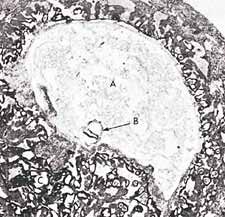
The third meaning of the word alaqah is “blood clot.” We find that the external appearance of the embryo and its sacs during the alaqah stage is similar to that of a blood clot. This is due to the presence of relatively large amounts of blood present in the embryo during this stage4 (see figure 4). Also during this stage, the blood in the embryo does not circulate until the end of the third week.5 Thus, the embryo at this stage is like a clot of blood. Figure 3: In this photomicrograph, we can see the suspension of an embryo (marked B) during the alaqah stage (about 15 days old) in the womb of the mother. The actual size of the embryo is about 0.6 mm. (The Developing Human, Moore, 3rd ed., p. 66, from Histology, Leeson and Leeson.)

Figure 4: Diagram of the primitive cardiovascular system in an embryo during the alaqah stage. The external appearance of the embryo and its sacs is similar to that of a blood clot, due to the presence of relatively large amounts of blood present in the embryo. (The Developing Human, Moore, 5th ed., p. 65.) (Click on the image to enlarge it.)
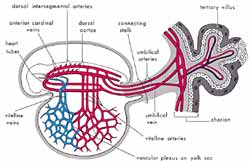
So the three meanings of the word alaqah correspond accurately to the descriptions of the embryo at the alaqah stage. 
The next stage mentioned in the verse is the mudghah stage. The Arabic word mudghah means “chewed substance.” If one were to take a piece of gum and chew it in his or her mouth and then compare it with an embryo at the mudghah stage, we would conclude that the embryo at the mudghah stage acquires the appearance of a chewed substance. This is because of the somites at the back of the embryo that “somewhat resemble teethmarks in a chewed substance.”6 (see figures 5 and 6).
Figure 5: Photograph of an embryo at the mudghah stage (28 days old). The embryo at this stage acquires the appearance of a chewed substance, because the somites at the back of the embryo somewhat resemble teeth marks in a chewed substance. The actual size of the embryo is 4 mm. (The Developing Human, Moore and Persaud, 5th ed., p. 82, from Professor Hideo Nishimura, Kyoto University, Kyoto, Japan.)
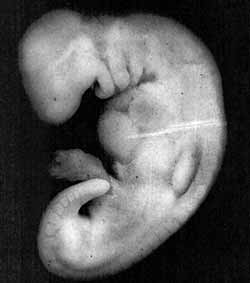
Figure 6: When comparing the appearance of an embryo at the mudghah stage with a piece of gum that has been chewed, we find similarity between the two.
A) Drawing of an embryo at the mudghah stage. We can see here the somites at the back of the embryo that look like teeth marks. (The Developing Human, Moore and Persaud, 5th ed., p. 79.)
B) Photograph of a piece of gum that has been chewed.
(Click on the image to enlarge it.)
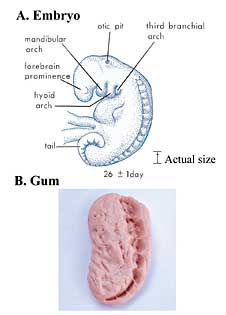
How could Muhammad 
Figure 6: When comparing the appearance of an embryo at the mudghah stage with a piece of gum that has been chewed, we find similarity between the two.
A) Drawing of an embryo at the mudghah stage. We can see here the somites at the back of the embryo that look like teeth marks. (The Developing Human, Moore and Persaud, 5th ed., p. 79.)
B) Photograph of a piece of gum that has been chewed.
(Click on the image to enlarge it.)

 have possibly known all this 1400 years ago, when scientists have only recently discovered this using advanced equipment and powerful microscopes which did not exist at that time? Hamm and Leeuwenhoek were the first scientists to observe human sperm cells (spermatozoa) using an improved microscope in 1677 (more than 1000 years after Muhammad
have possibly known all this 1400 years ago, when scientists have only recently discovered this using advanced equipment and powerful microscopes which did not exist at that time? Hamm and Leeuwenhoek were the first scientists to observe human sperm cells (spermatozoa) using an improved microscope in 1677 (more than 1000 years after Muhammad  ). They mistakenly thought that the sperm cell contained a miniature preformed human being that grew when it was deposited in the female genital tract.7
). They mistakenly thought that the sperm cell contained a miniature preformed human being that grew when it was deposited in the female genital tract.7 Professor Emeritus Keith L. Moore8 is one of the world’s most prominent scientists in the fields of anatomy and embryology and is the author of the book entitled The Developing Human, which has been translated into eight languages. This book is a scientific reference work and was chosen by a special committee in the United States as the best book authored by one person. Dr. Keith Moore is Professor Emeritus of Anatomy and Cell Biology at the University of Toronto, Toronto, Canada. There, he was Associate Dean of Basic Sciences at the Faculty of Medicine and for 8 years was the Chairman of the Department of Anatomy. In 1984, he received the most distinguished award presented in the field of anatomy in Canada, the J.C.B. Grant Award from the Canadian Association of Anatomists. He has directed many international associations, such as the Canadian and American Association of Anatomists and the Council of the Union of Biological Sciences.
In 1981, during the Seventh Medical Conference in Dammam, Saudi Arabia, Professor Moore said: “It has been a great pleasure for me to help clarify statements in the Quran about human development. It is clear to me that these statements must have come to Muhammad from God, because almost all of this knowledge was not discovered until many centuries later. This proves to me that Muhammad must have been a messenger of God.”9 (To view the RealPlayer video of this comment click here
 ).
). Consequently, Professor Moore was asked the following question: “Does this mean that you believe that the Quran is the word of God?” He replied: “I find no difficulty in accepting this.”10
During one conference, Professor Moore stated: “....Because the staging of human embryos is complex, owing to the continuous process of change during development, it is proposed that a new system of classification could be developed using the terms mentioned in the Quran and Sunnah (what Muhammad
 said, did, or approved of). The proposed system is simple, comprehensive, and conforms with present embryological knowledge. The intensive studies of the Quran and hadeeth (reliably transmitted reports by the Prophet Muhammad’s
said, did, or approved of). The proposed system is simple, comprehensive, and conforms with present embryological knowledge. The intensive studies of the Quran and hadeeth (reliably transmitted reports by the Prophet Muhammad’s  companions of what he said, did, or approved of) in the last four years have revealed a system for classifying human embryos that is amazing since it was recorded in the seventh century A.D. Although Aristotle, the founder of the science of embryology, realized that chick embryos developed in stages from his studies of hen’s eggs in the fourth century B.C., he did not give any details about these stages. As far as it is known from the history of embryology, little was known about the staging and classification of human embryos until the twentieth century. For this reason, the descriptions of the human embryo in the Quran cannot be based on scientific knowledge in the seventh century. The only reasonable conclusion is: these descriptions were revealed to Muhammad from God. He could not have known such details because he was an illiterate man with absolutely no scientific training.”11
companions of what he said, did, or approved of) in the last four years have revealed a system for classifying human embryos that is amazing since it was recorded in the seventh century A.D. Although Aristotle, the founder of the science of embryology, realized that chick embryos developed in stages from his studies of hen’s eggs in the fourth century B.C., he did not give any details about these stages. As far as it is known from the history of embryology, little was known about the staging and classification of human embryos until the twentieth century. For this reason, the descriptions of the human embryo in the Quran cannot be based on scientific knowledge in the seventh century. The only reasonable conclusion is: these descriptions were revealed to Muhammad from God. He could not have known such details because he was an illiterate man with absolutely no scientific training.”11
إظهار التوقيع
توقيع : sho_sho
التوقيع لا يظهر للزوار ..
- مشاركات sho_sho
- عدد المواضيـع :
- عدد الـــــــردود :
- المجمــــــــــوع : 10,143
#2
sho_sho
عضوة مـآسية
 رد: The Quran on Human Embryonic Development:
رد: The Quran on Human Embryonic Development:
أ) القرآن الكريم على التنمية البشرية الجنينية :
في القرآن الكريم ، والله يتحدث عن مراحل التطور الجنيني الرجل :
لقد خلقنا الإنسان من مستخرج من الطين . ثم جعلنا له بأنه انخفاض في مكان التسوية ، رسخت . ثم جعلنا قطرة إلى مضغة ( علقة ، علقت الشيء ، و تجلط الدم) ، ثم جعلنا مضغة إلى مضغة ( يمضغ الجوهر ) ... 1 (القرآن الكريم، 23:12-14 )
حرفيا ، والكلمة العربية علقة لها ثلاثة معان : (1 ) علقة ، ( 2) علقت الشيء، و (3 ) تجلط الدم .
في مقارنة لعلقة إلى أن الجنين في مرحلة العلقة ، نجد تشابها بين two2 كما يمكننا أن نرى في الشكل 1 . أيضا ، أن الجنين في هذه المرحلة يحصل على الغذاء من دم الأم ، على غرار علقة ، والتي تتغذى على الدم من others.3
الشكل 1

الشكل 1 : رسومات توضح أوجه التشابه في المظهر بين علقة والجنين البشري في مرحلة مضغة . ( علقة مستفيدة من التنمية البشرية كما هو موضح في القرآن والسنة، مور وغيرهم ، ص 37 ، من تعديل المبادئ المتكاملة ل علم الحيوان ، هيكمان وغيرها. الأجنة من الرسم وتطوير القدرات البشرية ومور وبيرسود ، 5th الطبعه، ص . 73 . )
المعنى الثاني لل مضغة كلمة "علق شيء . " هذا ما يمكننا أن نرى في الشكلين 2 و 3، و التعليق من الجنين ، خلال المرحلة مضغة ، في رحم الأم.
الشكل 2
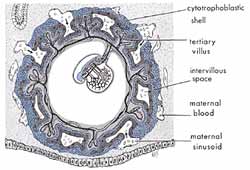
: ويمكننا أن نرى في هذا المخطط تعليق جنين خلال المرحلة مضغة في الرحم ( الرحم ) من الأم. ( وتطوير القدرات البشرية ومور وبيرسود ، 5th الطبعه، ص 66 . ) (اضغط على الصورة ل تكبيرها.)
الشكل 2

الشكل (3) : وفي هذا صورة مجهرية ، يمكننا أن نرى تعليق جنين ( ملحوظة ب ) خلال المرحلة مضغة (حوالي 15 يوما من العمر) في رحم الأم . الحجم الفعلي للالجنين حوالي 0.6 ملم . ( وتطوير القدرات البشرية ومور ، 3rd الطبعه ، ص 66 ، من الأنسجة ، ليسون و يسون . )
الشكل (3)

المعنى الثالث للمضغة كلمة "تجلط الدم . " نحن نجد أن المظهر الخارجي للجنين و الحويصلات خلال المرحلة مضغة هي مماثلة لتلك التي لتجلط الدم . ويرجع ذلك إلى وجود كميات كبيرة نسبيا من الدم الموجود في الجنين خلال هذه stage4 ( انظر الشكل 4) هذا . أيضا خلال هذه المرحلة ، والدم في الجنين لا تعمم حتى نهاية week.5 الثالث وهكذا، فإن الجنين في هذه المرحلة هو مثل تجلط الدم .
الشكل 4 :

رسم تخطيطي ل نظام القلب والأوعية الدموية البدائية في جنين خلال المرحلة مضغة . المظهر الخارجي للجنين والحويصلات مشابه ل تلك التي لتجلط الدم ، ويرجع ذلك إلى وجود كميات كبيرة نسبيا من الدم الموجود في الجنين . ( وتطوير القدرات البشرية ومور ، 5th الطبعه، ص 65 . ) (اضغط على الصورة ل تكبيرها.)
الشكل 4 ( اضغط هنا لتكبير الصورة )
حتى المعاني الثلاثة للمضغة كلمة تتطابق بدقة على أوصاف الجنين في مرحلة مضغة .
المرحلة التالية المذكورة في الآية هي المرحلة مضغة . الكلمة العربية مضغة يعني " يمضغ الجوهر . " إذا كان للمرء أن يأخذ قطعة من مضغ العلكة وذلك في فمه ومن ثم مقارنتها مع الجنين في مرحلة مضغة ، فإننا نخلص إلى أن الجنين في مرحلة يكتسب مضغة مظهر يمضغ الجوهر . هذا هو بسبب somites في الجزء الخلفي من الجنين الذي " يشبه الى حد ما teethmarks في يمضغ الجوهر . " 6 (انظر الشكلين 5 و 6) .

الشكل 5 : صور للجنين في مرحلة مضغة (28 يوما ) . الجنين في هذه المرحلة يكتسب مظهر يمضغ الجوهر ، لأن somites في الجزء الخلفي من الجنين إلى حد ما تشبه علامات الأسنان في يمضغ الجوهر . الحجم الفعلي للالجنين 4 مم . ( وتطوير القدرات البشرية ومور وبيرسود ، 5th الطبعه، ص 82 ، من البروفيسور هيديو نيشيمورا ، جامعة كيوتو ، كيوتو ، اليابان . )
الرقم 5
عند مقارنة مظهر الجنين في مرحلة مضغة مع قطعة من العلكة التي كانت تمضغ، نجد تشابها بين البلدين .
A) رسم لجنين في مرحلة مضغة . يمكننا أن نرى هنا و somites في الجزء الخلفي من الجنين الذي تبدو علامات الأسنان . ( وتطوير القدرات البشرية ومور وبيرسود ، 5th الطبعه، ص 79 . )
B ) صورة ل قطعة من العلكة التي كانت تمضغ .
كيف يمكن أن يكون محمد وربما يعرف كل هذا منذ 1400 سنة ، عندما اكتشف العلماء إلا مؤخرا باستخدام هذه المعدات المتطورة و المجاهر القوية التي لم تكن موجودة في ذلك الوقت؟ هام ويوينهويك كان العلماء أول لمراقبة الخلايا المنوية البشرية ( الحيوانات المنوية ) باستخدام مجهر تحسنت عام 1677 (بعد أكثر من 1000 سنة محمد) . ظنوا خطأ أن الخلايا المنوية الواردة مصغر بريفورميد إنسان التي نشأت عندما كانت مودعة في الأنثى tract.7 الأعضاء التناسلية
أستاذ متفرغ كيث Moore8 هو واحد من أبرز العلماء في العالم في مجال علم التشريح و علم الأجنة و هو مؤلف كتاب بعنوان وتطوير القدرات البشرية ، والتي ترجمت إلى ثماني لغات . هذا الكتاب هو المرجع العلمي والعمل تم اختياره من قبل لجنة خاصة في الولايات المتحدة باعتباره أفضل كتاب من تأليف شخص واحد . الدكتور كيث مور هو أستاذ شرفي للتشريح و بيولوجيا الخلية في جامعة تورونتو ، تورونتو ، كندا . هناك ، كان معاون عميد كلية العلوم الأساسية في كلية الطب لمدة 8 سنوات وكان رئيس قسم التشريح . في عام 1984 ، حصل على الجائزة الأكثر تميزا المقدمة في مجال التشريح في كندا، و JCB منح جائزة تقديرية من جمعية علماء التشريح الكندية . فقد توجه العديد من الجمعيات الدولية ، مثل الجمعية الكندية والأمريكية لعلماء التشريح ومجلس الاتحاد للعلوم البيولوجية .
، أثناء المؤتمر الطبي السابع في الدمام ، قالت المملكة العربية السعودية ، البروفسور مور في عام 1981 : "لقد كان من دواعي سروري عظيم بالنسبة لي للمساعدة في توضيح البيانات الواردة في القرآن الكريم حول التنمية البشرية . ومن الواضح لي أن هذه التصريحات يجب ان يأتي من الله على محمد ، وذلك لأن ما يقرب من جميع هذه المعرفة لم تكتشف حتى قرون عديدة في وقت لاحق . هذا يثبت لي أن محمدا لا بد ان يكون رسول الله "..
وبالتالي، البروفسور مور سئل السؤال التالي : " هل يعني هذا أن كنت تعتقد أن القرآن هو كلام الله " فأجاب : " لا أجد صعوبة في قبول هذا . " 10
خلال مؤتمر واحد ، وذكر البروفسور مور : " .... لأن التدريج الأجنة البشرية معقدة ، نظرا ل عملية مستمرة من خلال تغيير التنمية ، ويقترح أن نظام جديد للتصنيف يمكن تطويرها باستخدام للشروط المذكورة في ( ما قال محمد ، لم، أو وافقت ل) القرآن والسنة . النظام المقترح هو بسيط وشامل ، و يتفق مع المعارف الجنينية الحالي . وقد كشفت الدراسات المكثفة للقرآن و الحديث ( التقارير المرسلة موثوق بها صحابة النبي محمد في ما قاله ، لم، أو وافقت ل) في السنوات الأربع الماضية جود نظام لتصنيف الأجنة البشرية التي يتم مذهلة منذ أن تم تسجيلها في السابع الميلادي على الرغم من أن أرسطو ، مؤسس علم الأجنة ، أدركت أن افراخ الدجاج في المراحل المتقدمة من دراسته للدجاجة البيض في القرن الرابع قبل الميلاد ، وقال انه لم يعط اي تفاصيل حول هذه المراحل . بقدر ما هو معروف من تاريخ علم الأجنة، لم يعرف إلا القليل عن تنظيم وتصنيف الأجنة البشرية حتى القرن العشرين . لهذا السبب ، لا يمكن أن يقوم أوصاف الأجنة البشرية في القرآن على المعرفة العلمية في القرن السابع الميلادي . الاستنتاج الوحيد المعقول هو : هذه الأوصاف قد أنزل على محمد من الله . انه لا يستطيع أن يعرف مثل هذه التفاصيل لأنه كان رجل أمي على الاطلاق مع أي التدريب العلمي . .
في القرآن الكريم ، والله يتحدث عن مراحل التطور الجنيني الرجل :
لقد خلقنا الإنسان من مستخرج من الطين . ثم جعلنا له بأنه انخفاض في مكان التسوية ، رسخت . ثم جعلنا قطرة إلى مضغة ( علقة ، علقت الشيء ، و تجلط الدم) ، ثم جعلنا مضغة إلى مضغة ( يمضغ الجوهر ) ... 1 (القرآن الكريم، 23:12-14 )
حرفيا ، والكلمة العربية علقة لها ثلاثة معان : (1 ) علقة ، ( 2) علقت الشيء، و (3 ) تجلط الدم .
في مقارنة لعلقة إلى أن الجنين في مرحلة العلقة ، نجد تشابها بين two2 كما يمكننا أن نرى في الشكل 1 . أيضا ، أن الجنين في هذه المرحلة يحصل على الغذاء من دم الأم ، على غرار علقة ، والتي تتغذى على الدم من others.3
الشكل 1

الشكل 1 : رسومات توضح أوجه التشابه في المظهر بين علقة والجنين البشري في مرحلة مضغة . ( علقة مستفيدة من التنمية البشرية كما هو موضح في القرآن والسنة، مور وغيرهم ، ص 37 ، من تعديل المبادئ المتكاملة ل علم الحيوان ، هيكمان وغيرها. الأجنة من الرسم وتطوير القدرات البشرية ومور وبيرسود ، 5th الطبعه، ص . 73 . )
المعنى الثاني لل مضغة كلمة "علق شيء . " هذا ما يمكننا أن نرى في الشكلين 2 و 3، و التعليق من الجنين ، خلال المرحلة مضغة ، في رحم الأم.
الشكل 2

: ويمكننا أن نرى في هذا المخطط تعليق جنين خلال المرحلة مضغة في الرحم ( الرحم ) من الأم. ( وتطوير القدرات البشرية ومور وبيرسود ، 5th الطبعه، ص 66 . ) (اضغط على الصورة ل تكبيرها.)
الشكل 2

الشكل (3) : وفي هذا صورة مجهرية ، يمكننا أن نرى تعليق جنين ( ملحوظة ب ) خلال المرحلة مضغة (حوالي 15 يوما من العمر) في رحم الأم . الحجم الفعلي للالجنين حوالي 0.6 ملم . ( وتطوير القدرات البشرية ومور ، 3rd الطبعه ، ص 66 ، من الأنسجة ، ليسون و يسون . )
الشكل (3)

المعنى الثالث للمضغة كلمة "تجلط الدم . " نحن نجد أن المظهر الخارجي للجنين و الحويصلات خلال المرحلة مضغة هي مماثلة لتلك التي لتجلط الدم . ويرجع ذلك إلى وجود كميات كبيرة نسبيا من الدم الموجود في الجنين خلال هذه stage4 ( انظر الشكل 4) هذا . أيضا خلال هذه المرحلة ، والدم في الجنين لا تعمم حتى نهاية week.5 الثالث وهكذا، فإن الجنين في هذه المرحلة هو مثل تجلط الدم .
الشكل 4 :

رسم تخطيطي ل نظام القلب والأوعية الدموية البدائية في جنين خلال المرحلة مضغة . المظهر الخارجي للجنين والحويصلات مشابه ل تلك التي لتجلط الدم ، ويرجع ذلك إلى وجود كميات كبيرة نسبيا من الدم الموجود في الجنين . ( وتطوير القدرات البشرية ومور ، 5th الطبعه، ص 65 . ) (اضغط على الصورة ل تكبيرها.)
الشكل 4 ( اضغط هنا لتكبير الصورة )
حتى المعاني الثلاثة للمضغة كلمة تتطابق بدقة على أوصاف الجنين في مرحلة مضغة .
المرحلة التالية المذكورة في الآية هي المرحلة مضغة . الكلمة العربية مضغة يعني " يمضغ الجوهر . " إذا كان للمرء أن يأخذ قطعة من مضغ العلكة وذلك في فمه ومن ثم مقارنتها مع الجنين في مرحلة مضغة ، فإننا نخلص إلى أن الجنين في مرحلة يكتسب مضغة مظهر يمضغ الجوهر . هذا هو بسبب somites في الجزء الخلفي من الجنين الذي " يشبه الى حد ما teethmarks في يمضغ الجوهر . " 6 (انظر الشكلين 5 و 6) .

الشكل 5 : صور للجنين في مرحلة مضغة (28 يوما ) . الجنين في هذه المرحلة يكتسب مظهر يمضغ الجوهر ، لأن somites في الجزء الخلفي من الجنين إلى حد ما تشبه علامات الأسنان في يمضغ الجوهر . الحجم الفعلي للالجنين 4 مم . ( وتطوير القدرات البشرية ومور وبيرسود ، 5th الطبعه، ص 82 ، من البروفيسور هيديو نيشيمورا ، جامعة كيوتو ، كيوتو ، اليابان . )
الرقم 5
عند مقارنة مظهر الجنين في مرحلة مضغة مع قطعة من العلكة التي كانت تمضغ، نجد تشابها بين البلدين .
A) رسم لجنين في مرحلة مضغة . يمكننا أن نرى هنا و somites في الجزء الخلفي من الجنين الذي تبدو علامات الأسنان . ( وتطوير القدرات البشرية ومور وبيرسود ، 5th الطبعه، ص 79 . )
B ) صورة ل قطعة من العلكة التي كانت تمضغ .
كيف يمكن أن يكون محمد وربما يعرف كل هذا منذ 1400 سنة ، عندما اكتشف العلماء إلا مؤخرا باستخدام هذه المعدات المتطورة و المجاهر القوية التي لم تكن موجودة في ذلك الوقت؟ هام ويوينهويك كان العلماء أول لمراقبة الخلايا المنوية البشرية ( الحيوانات المنوية ) باستخدام مجهر تحسنت عام 1677 (بعد أكثر من 1000 سنة محمد) . ظنوا خطأ أن الخلايا المنوية الواردة مصغر بريفورميد إنسان التي نشأت عندما كانت مودعة في الأنثى tract.7 الأعضاء التناسلية
أستاذ متفرغ كيث Moore8 هو واحد من أبرز العلماء في العالم في مجال علم التشريح و علم الأجنة و هو مؤلف كتاب بعنوان وتطوير القدرات البشرية ، والتي ترجمت إلى ثماني لغات . هذا الكتاب هو المرجع العلمي والعمل تم اختياره من قبل لجنة خاصة في الولايات المتحدة باعتباره أفضل كتاب من تأليف شخص واحد . الدكتور كيث مور هو أستاذ شرفي للتشريح و بيولوجيا الخلية في جامعة تورونتو ، تورونتو ، كندا . هناك ، كان معاون عميد كلية العلوم الأساسية في كلية الطب لمدة 8 سنوات وكان رئيس قسم التشريح . في عام 1984 ، حصل على الجائزة الأكثر تميزا المقدمة في مجال التشريح في كندا، و JCB منح جائزة تقديرية من جمعية علماء التشريح الكندية . فقد توجه العديد من الجمعيات الدولية ، مثل الجمعية الكندية والأمريكية لعلماء التشريح ومجلس الاتحاد للعلوم البيولوجية .
، أثناء المؤتمر الطبي السابع في الدمام ، قالت المملكة العربية السعودية ، البروفسور مور في عام 1981 : "لقد كان من دواعي سروري عظيم بالنسبة لي للمساعدة في توضيح البيانات الواردة في القرآن الكريم حول التنمية البشرية . ومن الواضح لي أن هذه التصريحات يجب ان يأتي من الله على محمد ، وذلك لأن ما يقرب من جميع هذه المعرفة لم تكتشف حتى قرون عديدة في وقت لاحق . هذا يثبت لي أن محمدا لا بد ان يكون رسول الله "..
وبالتالي، البروفسور مور سئل السؤال التالي : " هل يعني هذا أن كنت تعتقد أن القرآن هو كلام الله " فأجاب : " لا أجد صعوبة في قبول هذا . " 10
خلال مؤتمر واحد ، وذكر البروفسور مور : " .... لأن التدريج الأجنة البشرية معقدة ، نظرا ل عملية مستمرة من خلال تغيير التنمية ، ويقترح أن نظام جديد للتصنيف يمكن تطويرها باستخدام للشروط المذكورة في ( ما قال محمد ، لم، أو وافقت ل) القرآن والسنة . النظام المقترح هو بسيط وشامل ، و يتفق مع المعارف الجنينية الحالي . وقد كشفت الدراسات المكثفة للقرآن و الحديث ( التقارير المرسلة موثوق بها صحابة النبي محمد في ما قاله ، لم، أو وافقت ل) في السنوات الأربع الماضية جود نظام لتصنيف الأجنة البشرية التي يتم مذهلة منذ أن تم تسجيلها في السابع الميلادي على الرغم من أن أرسطو ، مؤسس علم الأجنة ، أدركت أن افراخ الدجاج في المراحل المتقدمة من دراسته للدجاجة البيض في القرن الرابع قبل الميلاد ، وقال انه لم يعط اي تفاصيل حول هذه المراحل . بقدر ما هو معروف من تاريخ علم الأجنة، لم يعرف إلا القليل عن تنظيم وتصنيف الأجنة البشرية حتى القرن العشرين . لهذا السبب ، لا يمكن أن يقوم أوصاف الأجنة البشرية في القرآن على المعرفة العلمية في القرن السابع الميلادي . الاستنتاج الوحيد المعقول هو : هذه الأوصاف قد أنزل على محمد من الله . انه لا يستطيع أن يعرف مثل هذه التفاصيل لأنه كان رجل أمي على الاطلاق مع أي التدريب العلمي . .
إظهار التوقيع
توقيع : sho_sho
التوقيع لا يظهر للزوار ..
- مشاركات sho_sho
- عدد المواضيـع :
- عدد الـــــــردود :
- المجمــــــــــوع : 10,143
#3
zozoweza
عضوة برونزية
 رد: The Quran on Human Embryonic Development:
رد: The Quran on Human Embryonic Development:

إظهار التوقيع
توقيع : zozoweza
التوقيع لا يظهر للزوار ..
- مشاركات zozoweza
- عدد المواضيـع :
- عدد الـــــــردود :
- المجمــــــــــوع : 21,576
#4
fatma7072
عضوة ذهبية
 رد: The Quran on Human Embryonic Development:
رد: The Quran on Human Embryonic Development:
بارك الله فيكى
إظهار التوقيع
توقيع : fatma7072
التوقيع لا يظهر للزوار ..
- مشاركات fatma7072
- عدد المواضيـع :
- عدد الـــــــردود :
- المجمــــــــــوع : 9,484
#5
fatma7072
عضوة ذهبية
 رد: The Quran on Human Embryonic Development:
رد: The Quran on Human Embryonic Development:
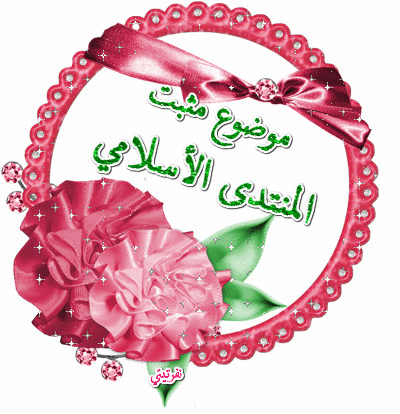
إظهار التوقيع
توقيع : fatma7072
التوقيع لا يظهر للزوار ..
- مشاركات fatma7072
- عدد المواضيـع :
- عدد الـــــــردود :
- المجمــــــــــوع : 9,484
 قد تكوني مهتمة بالمواضيع التالية ايضاً
قد تكوني مهتمة بالمواضيع التالية ايضاً
|
||||
| الموضوع | كاتب الموضوع | المنتدى | مشاركات | آخر مشاركة |
| 35 Simple Facts Every Muslim Should Know About the Holy Quran | حڸآۉة آڸرۉح | What is Islam | 5 | 13-01-2017 09:34 PM |
| Quran: The Word of God | للجنة اسعى❤ | What is Islam | 5 | 04-08-2016 06:25 AM |
| What is the Purpose of Life | ضــي القمــر | What is Islam | 3 | 25-05-2013 09:49 PM |
| The Quran on Human Embryonic Development | ضــي القمــر | What is Islam | 2 | 21-05-2013 04:53 PM |
| About the Holly Quran | ملآك ولكن.. | What is Islam | 4 | 25-12-2012 01:02 PM |
الساعة الآن 06:13 AM
جميع المشاركات تمثل وجهة نظر كاتبها وليس بالضرورة وجهة نظر الموقع
